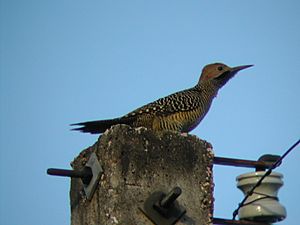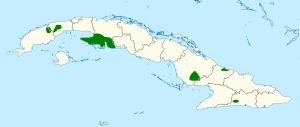Fernandina's flicker facts for kids
Quick facts for kids Fernandina's flicker |
|
|---|---|
 |
|
| Bermejas, Cuba | |
| Conservation status | |
| Scientific classification | |
| Genus: |
Colaptes
|
| Species: |
fernandinae
|
 |
|
| Synonyms | |
|
Nesoceleus fernandinae |
|
The Fernandina's flicker (scientific name: Colaptes fernandinae) is a special type of bird that belongs to the woodpecker family. It lives only in Cuba, which means it is endemic to that island. With only about 600 to 800 birds left, it is one of the most endangered woodpeckers on Earth. Its biggest threat is losing its habitat, the natural places where it lives.
Contents
What Does It Look Like?
The Fernandina's flicker is a medium-sized woodpecker. It grows to be about 14 to 15 inches (33 to 35 cm) long. Most of its body is a yellowish-tan color. It has black stripes that look like bars all over its feathers. The feathers under its wings are bright yellow. Male flickers have a black stripe that looks like a mustache, but female flickers do not have this stripe.
Where Does It Live?
The Fernandina's flicker lives only in Cuba. In the past, these birds were found all over the island, but they were never very common. Now, they live in only a few separate places in nine of Cuba's 15 provinces. These provinces include Camagüey, Cienfuegos, Granma, Holguín, Las Tunas, Matanzas, Pinar del Río, Santiago de Cuba, and Villa Clara.
The largest group of these flickers lives in the Zapata Swamp. About 120 pairs of birds were thought to live there. However, this number might have gone down after some recent hurricanes. Fernandina's flickers like to live in different kinds of places. These include dry forests, dry savannas, swamps, and pastures (fields where animals graze).
How Does It Behave?
The Fernandina's flicker is not a very social bird. However, sometimes they form small groups of up to 15 pairs. They are known to fight with other woodpeckers.
What Does It Eat?
Like other flickers, the Fernandina's flicker often looks for food on the ground. They mainly eat ants, but they also find other insects, worms, grubs, and seeds. They use their strong beaks to dig into the ground and push aside dead leaves to find their food.
Reproduction and Life Cycle
Fernandina's flickers breed between March and June. During this time, pairs of birds will chase each other high in the sky as part of their courtship. Like all woodpeckers, they make their nests inside holes in trees.
Scientists have found that these flickers often use nest holes that were started by West Indian woodpeckers. The flicker will chase away the original owners, finish digging out the hole, and then move in. The female flicker usually lays three to five white eggs. The parents sit on the eggs for about 18 days until they hatch. The young birds are ready to fly out of the nest after about 22 days.
What Does It Sound Like?
The Fernandina's flicker is often quiet. But when it does make sounds, its calls include a repeated "wicka" sound. This sound is actually where the whole group of flickers gets its common name. They also make a loud series of "pic" notes.
Why Is It Endangered?
With only about 600 to 800 birds left, the Fernandina's flicker is one of the most endangered woodpeckers in the world. The number of these birds is going down. The main reason for this is that they are losing their habitat.
Many things are causing their habitat to disappear. Farming, cutting down trees (logging), and damage from hurricanes are all making the places where these birds live smaller and more spread out. Also, some people try to catch baby Cuban amazon parrots to sell as pets. To do this, they cut down whole palm trees where these parrots nest. This also destroys homes for the flickers. In addition, West Indian woodpeckers have been seen killing the chicks of Fernandina's flickers.
See also
 In Spanish: Carpintero de la tierra para niños
In Spanish: Carpintero de la tierra para niños


